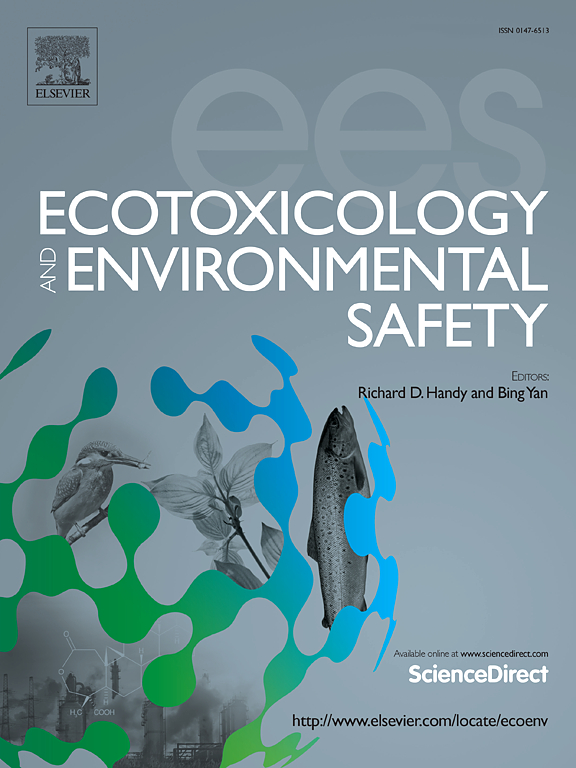中国典型草原小型哺乳动物活动对土壤微生物群落结构和杀鼠效应的协调作用
IF 6.2
2区 环境科学与生态学
Q1 ENVIRONMENTAL SCIENCES
引用次数: 0
摘要
土壤微生物群落是受土壤水分、理化性质、生物活性等因素影响的微生物物种的多样化组合。布氏田鼠(Lasiopodomys brandtii)是一种分布在中国、蒙古和俄罗斯典型草原上的小型啮齿动物,其种群爆发往往会给当地造成严重的危害。然而,灭鼠剂对勃兰特田鼠栖息地土壤微生物多样性和生态系统功能的影响尚不为人所知。在本研究中,我们比较了未受干扰的洞穴群落中心区和外围区,以及使用和不使用灭鼠剂的草地的微生物群落组成和功能基因。结果表明,田鼠和杀鼠剂的活性对土壤微生物群落、抗生素抗性基因和土壤元素循环有显著影响。灭鼠剂的使用减少了啮齿动物的活动,减少了土壤中的致病菌。杀鼠剂抑制氮循环,鼠类活动促进氮循环。杀鼠土壤中异化硝酸还原硝态氮(narGHI或napA)、反硝化氧化亚氮(nosZ)、固氮氮(nifH)、反硝化氧化亚氮(norB)的相对丰度显著降低。啮齿类动物的活动增加了土壤中特定抗生素抗性基因(ARGs)的丰度,而杀鼠剂则降低了土壤中特定抗生素抗性基因(agr)的丰度。我们的研究首次探讨了鼠类活动和灭鼠剂使用对土壤的相互作用,为今后了解土壤生态系统的多功能性和微生物群落对外部干扰(鼠类和人类)的响应提供了参考。本文章由计算机程序翻译,如有差异,请以英文原文为准。
Small mammal activities structure fine-scale soil microbial communities and coordinate rodenticide effects in the typical steppes of China
Soil microbial community is a diverse combination of microbial species that is influenced by soil moisture, physicochemical properties, biological activities, and other factors. Brandt's vole (Lasiopodomys brandtii) is a small rodent distributed in the typical steppes of China, Mongolia, and Russia, which often causes serious pest to the local areas when its population outbreaks. Yet the impacts of rodenticides on soil microbial diversity and ecosystem functions in Brandt’s vole habitats are not well-known. In this study, we compared the microbial community composition and functional genes between the central and peripheral areas of undisturbed cave communities, as well as grasslands with and without rodenticides. The results showed that the activity of field voles and rodenticides had a significant impact on soil microbial communities, antibiotic resistance genes, and soil element cycling. The use of rodenticides reduces the activity of rodents, reduces pathogenic bacteria in the soil. The use of rodenticides inhibits N cycling, while rodent activity promotes the N cycling. Relative abundance of dissimilatory nitrate reduction nitrate (narGHI or napA), denitrification nitrous oxide (nosZ), nitrogen fixation nitrogen (nifH), denitrification nitric oxide (norB) were significantly decreased in rodenticide soil. The activity of rodents increases the abundance of specific antibiotic resistance genes (ARGs), while rodenticides reduce the abundance of AGRs in the soil. Our study for the first time explores the interaction effects of rodent activity and rodenticide use on soil, providing a reference for understanding the multifunctionality of soil ecosystems and the response of microbial communities to external disturbances (rodents and humans) in the future.
求助全文
通过发布文献求助,成功后即可免费获取论文全文。
去求助
来源期刊
CiteScore
12.10
自引率
5.90%
发文量
1234
审稿时长
88 days
期刊介绍:
Ecotoxicology and Environmental Safety is a multi-disciplinary journal that focuses on understanding the exposure and effects of environmental contamination on organisms including human health. The scope of the journal covers three main themes. The topics within these themes, indicated below, include (but are not limited to) the following: Ecotoxicology、Environmental Chemistry、Environmental Safety etc.

 求助内容:
求助内容: 应助结果提醒方式:
应助结果提醒方式:


